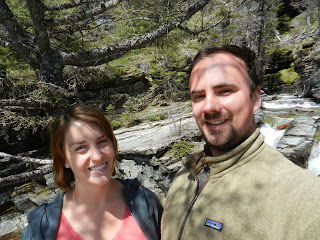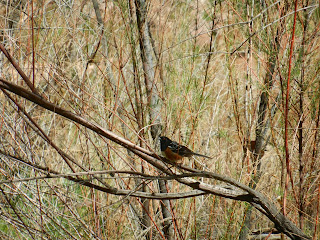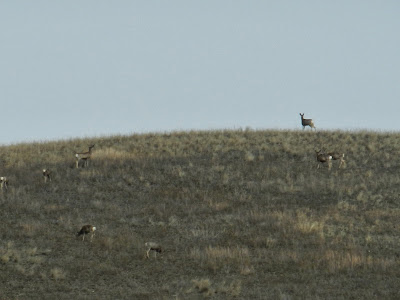The last week or so I have had the taste of spring in my mouth--it may be a little early (it's still quite wintery here), but signs are starting to appear. I saw a flock of robins on a particularly sunny day last week, and while I've actually been seeing the occasional robin all winter, the sheer number of them perched on every tree around us in groups of fifty to one hundred, all the while the air being filled with their noisy and jubilant calls, seemed like the first true sign of warmth and longer days to come. The sun felt like spring that day, too...warmer and more direct than it had all winter. And it almost qualifies as a miracle that I am coming home from work in the light of day now! Needless to say, I'm excited about this turn of season, but trying to remain patient, too. Seasons don't respond to anyone's desires, and that is most definitely true in Montana. I will enjoy the flurries of snow and the chill of the lingering winter wind, but I would be lying if I said that I am not anxiously watching the buds on trees and sniffing the air for the sweet scent of cottonwood for the real signs of spring to reveal themselves.
I must admit that the cold of winter and the lethargy brought on by it, and I suppose feeling ill and almost constantly tired from pregnancy, has made me a bit unengaged in my usual interest in keeping track of the daily changes in nature, and specifically, in our place. I am into my second trimester now and feeling a lot more energetic, and it just so happens that ice isn't covering the entire trail on the river anymore. So this is my unofficial vow to reengage myself! Hopefully that means more updates on the blog, too, but it at least means more sketches and writing in my naturalist journal. There is something about the newness of leaves and flowers, the birds that return after a winter away, and the smells and colors and feelings that accompany spring that invigorate my love for being outside. This is definitely not a unique phenomenon, I realize, but it's something I have observed in myself and hope that I can use as motivation to remain more committed to my naturalist studies and to immersing myself in nature in the winter as well.
As I mentioned, the ice is mostly gone on the river path now, so we have been taking our regular walks there again. I didn't stop walking down there completely this winter, but my relative absence has been obvious to me in being amazed by the dramatic way things have changed. The beaver(s) who hangs out there has been extremely busy. Remember from a previous post the tree I took a picture of that a beaver had gone to town on? Now it has gone to town on most of the mid-sized circumference trees along the river.
Pretty impressive, huh? I wish I could sneak up on he/she/them and watch this efficient work going down! I wonder how long it took to make this much progress? That's exactly why it's so important to go back to the same place
regularly...like,
really regularly. When you don't the story doesn't unfold, instead you're thrown into the middle of it. Lesson learned, right?
I've been seeing lots of
bald eagles lately. Driving from Coeur d' Alene to Missoula last weekend I watched several fly right over my car and perch on a tree along the Clark Fork. Year-round residents, woodpeckers, have been a constant all winter as well. On every walk I have taken this winter I have heard the familiar knocking and thumping high on a tree and looked up to see
red-naped sapsuckers,
downy woodpeckers,
hairy woodpeckers, or
pileated woodpeckers. Today we came across a downy woodpecker nearly at the top of an enormous cottonwood.
 |
| Not the greatest pic, but as I said, she was really high up this tree! It's like "Where's Waldo"...can you see her in there? |
A herd of
white-tailed deer were grazing up on the hillside across the river today--they spend a lot of time over there in the fall, but I haven't seen large group of them there in a while. I'm not sure if I just haven't been looking enough, or if they haven't been using that hillside as often this winter for whatever reason.
I'll end on a story that unfortunately I didn't get to experience myself but that I heard about first on
The Pea Green Boat (a great children's program on Montana Public Radio from 4-5 every day) and then I read about shortly after in the
Independent. In Polson a week or two ago there was an unusual phenomenon that occurred called an "irruption" of
snowy owls. This basically means, quoting from the article, "...a sudden, unpredictable mass movement of individuals into an area where they're uncommon" (Christine Nealson from "Winged Irruption" in
Missoula Independent, Vol. 23, No. 8). These owls came all the way from the Arctic, and scientists are not exactly sure why. There is speculation that there has been a lemming population dive, leading the owls to travel long distances for new sources of food (the lemming is the primary source of food). But others believe that it is in fact an
overpopulation of lemmings has allowed snowy owl populations to increase dramatically, pushing the "extra" birds out of the Arctic to search for food in other places. Irruptions have apparently been extraordinarily common this winter, owls showing up in the Midwest and Mountain West instead of only in their areas where they typically occur: the Northwest, Northeast, and British Columbia. Overall, they have been traveling much further south this year. Who knows what's going on. While it may be cause for concern, I also find it to be some sort of beautiful wonder of nature. I have never seen a snowy owl and only wish I would have known about this in time to go see them, but just the thought of an "irruption" fills me with awe. And while there's no replacement for direct experience, I am grateful that even those wonders of nature that I have never experienced personally I still get to learn about through the many amazing naturalists around the world. This is to say, we should all share our observations and learn from one another--"professional" naturalist or not. It's one of the great gifts of being a lover of nature.



















































